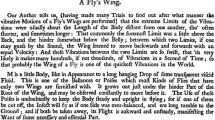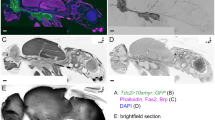Summary
-
1.
The age-dependence of the modulatory actions of octopamine on the dorsal longitudinal flight muscle of the locust,Schistocerca gregaria, is described.
-
2.
The maximal levels of octopaminergic potentiation of the amplitude and of the rates of contraction and relaxation of twitch tension occurred in the late 5th instar hopper and in the adult at the day of moulting. After 1 day of adult life the effects on twitch amplitude and contraction rate had declined to basal levels which were maintained for up to 28 days. The effect on the relaxation rate declined progressively up to day 7 of adult life before reaching a maintained level. Parallel effects were observed for the changes mediated by stimulation of the dorsal unpaired median modulatory octopaminergic neurone (DUMDL) to this muscle.
-
3.
The octopamine-induced changes in the physiological parameters of twitch tension exhibited motor unit specificity as did changes in the octopamine-mediated increases in cyclic AMP levels.
-
4.
Studies on the age-dependence of the modulatory effects of exogenously applied cyclic nucleotides suggest that age-dependent changes occur at multiple sites in the response cascade between the activation of octopamine receptors and the observed physiological responses.
Similar content being viewed by others
Abbreviations
- DUMDL :
-
dorsal unpaired median modulatory octopaminergic neurone
- IBMX :
-
3-isobutyl-1-methylxanthine
Reference
Altman JS (1975) Changes in the flight motor pattern during the development of the Australian plague locust,Chortoicetes terminifera. J Comp Physiol 97:127–142
Arbas EA (1983) Neural correlates of flight loss in a Mexican grasshopper,Barytettix psolus. I. Motor and sensory cells. J Comp Neurol 216:369–380
Arbas EA, Tolbert LP (1986) Presynaptic terminals persist following degeneration of ‘flight’ muscle during development of a flightless grasshopper. J Neurobiol 17:627–636
Bailey BA, Martin RJ, Downer RGH (1983) Haemolymph octopamine levels during and following flight in the American cockroachPeriplaneta americana L. Can J Zool 62:19–22
Bentley DR (1973) Postembryonic development of insect motor systems. In: Young D (ed) Developmental neurobiology of arthropods. Cambridge University Press, Cambridge, pp 147–177
Bernays EA (1972) The muscles of newly hatchedSchistocerca gregaria larvae and their possible functions in hatching, digging and ecdysial movements (Insecta: Acrididae). J Zool (Lond) 166:141–158
Bowman WC (1982) Effects of adrenergic activation and inhibitors on the skeletal muscles. In: Szekeres L (ed) Handbook of experimental pharmacology adrenergic activators and inhibitors, vol 54, part II. Springer, Berlin Heidelberg New York, pp 47–128
Brown BL, Ekins RP, Albano JDM (1972) Saturation assay for cyclic AMP using endogenous binding protein. Adv Cyclic Nucleotide Res 2:25–40
Buchan PB, Evans PD (1980) Use of an operational amplifier signal differentiator reveals that octopamine increases the rate of development of neurally evoked tension in insect muscle. J Exp Biol 85:349–352
Davis NT, Alanis J (1979) Morphological and electrophysiological characteristics of a dorsal unpaired median neuron of the cricketAcheta dotnesticus. Comp Biochem Physiol 62A:777–788
Evans PD (1981) Multiple receptor types for octopamine in the locust. J Physiol 318:99–122
Evans PD (1984) A modulatory octopaminergic neurone increases cyclic nucleotide levels in locust skeletal muscle. J Physiol (Lond) 348:307–324
Evans PD (1987) Phenyliminoimidazolidine derivatives activate both Octopaminel and Octopamine2 receptor subtypes in locust skeletal muscle. J Exp Biol 129:239–250
Evans PD, Myers CM (1986) Peptidergic and aminergic modulation of insect skeletal muscle. J Exp Biol 124:143–176
Goosey MW, Candy DJ (1980) The D-octopamine content of the haemolymph of the locustSchistocerca americana gregaria and its elevation during flight. Insect Biochem 10:393–397
Goosey MW, Candy DJ (1982) The release and removal of octopamine by tissues of the locustSchistocerca americana gregaria. Insect Biochem 12:681–685
Govind CK, Pearce J (1981) Remodelling of multiterminal innervation by nerve terminal sprouting in an identifiable lobster motoneurone. Science 212:1522–1524
Greenberg SM, Castellucci VF, Bayley H, Schwartz JH (1987) A molecular mechanism for long-term sensitization inAplysia. Nature (Lond) 329:62–65
Hoyle G (1978) The dorsal, unpaired, median neurons of the locust metathoracic ganglion. J Neurobiol 9:43–57
Hoyle G, Colquhoun W, Williams M (1980) Fine structure of an octopaminergic neuron and its terminals. J Neurobiol 11:103–126
Kutsch W (1971) The development of the flight pattern in the desert locustSchistocerca gregaria. Z Vergl Physiol 74:156–168
Lowry OH, Rosebrough NJ, Farr AL, Randall RJ (1951) Protein measurement with the Folin phenol reagent. J Biol Chem 193:265–275
Malamud JG, Mizisin AP, Josephson RK (1988) The effects of octopamine on contraction kinetics and power output of a locust flight muscle. J Comp Physiol A 162:827–835
Mayer RJ, Candy DJ (1969) Control of haemolymph lipid concentration during locust flight: an adipokinetic hormone from the corpora cardiaca. J Insect Physiol 15:611–620
Mizisin AP, Ready NE (1986) Growth and development of flight muscle in the locust (Schistocerca nitens Thunberg). J Exp Zool 237:45–55
Morton DB, Truman JW (1986) Substrate phosphoprotein availability regulates eclosion hormone sensitivity in an insect CNS. Nature 323:264–267
Morton DB, Truman JW (1988a) The EGP's: The eclosion hormone and cyclic GMP-regulated phosphoproteins: I. Appearance and partial characterization in the CNS ofManduca sexta. J Neurosci 8:1326–1337
Morton DB, Truman JW (1988b) The EGP's: The eclosion hormone and cyclic GMP-regulated phosphoproteins: II. Regulation of appearance by the steroid hormone 20-hydroxyecdysone inManduca sexta. J Neurosci 8:1338–1345
Mwangi RW, Goldsworthy GJ (1977) Age-related changes in the response to adipokinetic hormone inLocusta migratoria. Physiol Entomol 2:37–42
Neville AC (1963) Motor unit distribution of the dorsal longitudinal flight muscles in locusts. J Exp Biol 40:123–136
Neville AC, Weis-Fogh T (1963) The effect of temperature on locust flight muscle. J Exp Biol 40:111–121
Panar LC, Nair KK (1975) Cytochemistry of the differentiating flight muscles of the desert locustSchistocerca gregaria. Histochemistry 45:129–141
Reddy NB, Oliver KL, Engel WK (1979) Differences in catecholamine-sensitive adenylate cyclase andΒ-adrenergic receptor binding between fast-twitch and slow-twitch skeletal muscle membranes. Life Sci 24:1765–1772
Redfern PA (1970) Neuromuscular transmission in new-born rats. J Physiol (Lond) 209:701–709
Robinson NL, Goldsworthy GJ (1977) A possible site of action for adipokinetic hormone on the flight muscle of locusts. J Insect Physiol 23:153–158
Sombati S, Hoyle G (1984) Generation of specific behaviors in a locust by local release into neuropil of the natural neuromodulator octopamine. J Neurobiol 15:481–506
Stephens PJ, Govind CK (1981) Peripheral innervation fields of single lobster motoneurons defined by synapse elimination during development. Brain Res 212:476–480
Stevenson PA, Kutsch W (1987) A reconsideration of the central pattern generator concept for locust flight. J Comp Physiol A 161:115–129
Stevenson PA, Kutsch W (1988) Demonstration of functional connectivity of the flight motor system in all stages of the locust. J Comp Physiol A 162:247–259
Thomas JG (1954) The postembryonic development of the dorsal part of the pterothoracic skeleton and certain muscles ofLocusta migratoria migratoroides. Proc Zool Soc Lond 124:229–238
Watson AHD (1984) The dorsal unpaired median neurones of the locust metathoracic ganglion: neuronal structure and diversity, and synapse distribution. J Neurocytol 13:303–327
Whim MD, Evans PD (1988) Octopaminergic modulation of flight muscle in the locust. J Exp Biol 134:247–266
Wolf H, Pearson KG (1987) Flight motor patterns recorded in surgically isolated sections of the ventral nerve cord ofLocusta migratoria. J Comp Physiol A 161:103–114
Author information
Authors and Affiliations
Rights and permissions
About this article
Cite this article
Whim, M.D., Evans, P.D. Age-dependence of octopaminergic modulation of flight muscle in the locust. J. Comp. Physiol. 165, 125–137 (1989). https://doi.org/10.1007/BF00613806
Accepted:
Issue Date:
DOI: https://doi.org/10.1007/BF00613806




